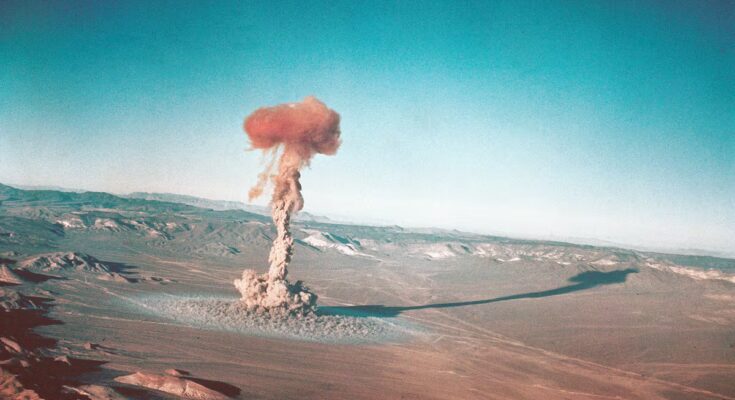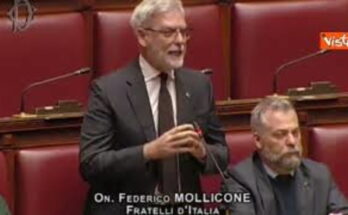Minutes before meeting with Xi Jinping in Busan, US President Donald Trump said he had ordered the US Department of Defense to “immediately” resume nuclear weapons testing. The announcement sparked a mix of alarm and confusion among the negotiating team that had traveled with the Chinese leader to the South Korean city, as well as to Beijing, Moscow and even Washington.
The US president hinted that the world’s leading power might once again detonate atomic bombs – a practice only North Korea has carried out this century – just hours after Russian President Vladimir Putin boasted of successfully testing a nuclear-powered underwater drone capable of devastating entire cities. This comes just months before the last treaty limiting U.S. and Russian nuclear arsenals expires, marking the potential end of the era of nuclear control established during the Cold War.
Trump’s October 30 post on Truth Social, the social network he owns, on his way to meeting with Xi was ambiguous and contained numerous falsehoods. “We have more nuclear weapons than anyone else,” the message began, even though Russia has more of them than the United States. Trump also falsely claimed that China will “break even within five years.” The Republican claimed that during his first term there was a “complete upgrade and renovation” of US atomic bombs, although in reality the Pentagon is about to launch the first major modernization of its nuclear arsenal since the Cold War – a project born under the Obama administration, with an expected investment of $1 trillion over the next ten years (roughly the GDP of Switzerland).
Above all, Trump’s post from Busan raised many questions about whether the president was referring to the resumption of nuclear testing, which has been in a de facto moratorium for more than 30 years, or the testing of strategic nuclear weapons delivery systems.
Trump was less ambiguous a couple of days later, when asked in a television interview whether he had ordered nuclear tests in the strict sense, that is, whether the United States would detonate atomic bombs for the first time since 1992. “I’m saying we will test nuclear weapons like other countries do, yes,” he told CBS from his golf club in Florida, before boasting that America’s arsenal could “blow up the world 150 times.” “We need to see how they work,” the president said, adding that Russia, China, Pakistan and North Korea conduct secret nuclear tests – “they don’t talk about it (…) they don’t have journalists who will write about it,” he argued. “We are the only country that doesn’t test,” Trump concluded.
Beijing, Moscow and Islamabad responded quickly to Trump’s accusations, saying they respected the informal moratorium banning nuclear tests since the late 1990s. On the same day, US Energy Secretary Chris Wright tried to calm concerns, saying: “The tests we’re talking about right now are not (…) nuclear explosions.” “You’re testing all the other parts of a nuclear weapon to make sure they provide the appropriate geometry and cause a nuclear explosion,” Wright told Fox News.
Daniel Salisbury, a researcher at the International Institute for Strategic Studies, believes it is “unlikely” that Washington will summarize underground nuclear tests. “In theory, the United States retains the ability to conduct a nuclear test within 36 months. However, reopening the Nevada National Security Site (where nearly a thousand nuclear tests have been conducted over the past century) would be an extraordinarily controversial, expensive, and lengthy process,” he said in an article.
Trump’s incendiary announcement from Busan, more than a message to China – and it was – seemed to respond to the veiled threats against the United States launched by Putin a few hours earlier. During a visit to a military hospital in Moscow, the Russian president said he had just conducted a test of a “superweapon”: the Poseidon torpedo, a nuclear-powered underwater drone designed to travel thousands of people and create a radioactive tsunami capable of destroying coastal cities. The power of its nuclear warhead is “significantly higher than that of our most advanced Sarmat intercontinental ballistic missile,” Putin said, surrounded by wounded soldiers in Ukraine. “There is nothing like this unmanned vehicle anywhere in the world,” he added. “And there’s no way to intercept it.”
A few days before boasting about the supposed success of the Poseidon test, the Russian leader informed senior military commanders, during a televised meeting, that he had completed “a final successful test” of the Burevestnik: a nuclear-powered cruise missile capable of carrying atomic warheads and, according to Putin, “with unlimited range.” Both Poseidon and Burevestnik are strategic weapons of mass destruction, designed to strengthen Russia’s deterrence capability and intended solely for use in the event of a nuclear attack.
It is not unusual for the Russian military to test its most advanced weapons, nor for the Kremlin to display them. In 2018, during his state of the nation address, Putin boasted of “six super weapons” in development, including the Poseidon torpedo and the Burevestnik – a missile “with virtually unlimited range, an unpredictable flight path (…) (which) is invulnerable to all existing and future anti-missile and air defense weapons,” he noted at the time.
Even more significant is the moment when the Russian president announced the success of the Poseidon and Burevestnik tests. After months of frenetic diplomatic activity, during which Trump seemed confident he could bring Putin and his Ukrainian counterpart Volodymyr Zelenskiy to the same negotiating table, the American president’s efforts to end the war between the two former Soviet republics appear to have cooled. Just days before Putin praised the capabilities of Poseidon and Burevestnik, the White House canceled a scheduled meeting between Trump and Putin in Budapest and imposed sanctions on Lukoil and Rosneft, two giants of the Russian oil industry.
Nuclear blackmail as a pressure tactic
With the large-scale invasion of Ukraine launched by Russian troops in February 2022, tanks and trenches returned to the Old Continent, as did nuclear blackmail to intimidate Kiev’s allies. Most analysts agree that the Kremlin’s boasts about its atomic arsenal should be interpreted less as direct threats and more as a tool of diplomatic pressure; a way to remind the West – especially Washington – that if Russia felt cornered and unable to achieve its goals in Ukraine, the risk of a nuclear apocalypse would increase.
After Trump’s announcement in South Korea, the Kremlin reacted quickly. “We hope that information about the Burevestnik and Poseidon tests has been adequately communicated to President Trump,” presidential spokesman Dmitry Peskov told the TASS news agency, “these tests cannot be regarded as nuclear in any way.” After Trump claimed in his CBS interview that Russia was conducting secret nuclear tests, Putin flatly denied the allegation but warned that Russia would resume testing weapons of mass destruction if Washington made the first move.
The increased use of nuclear rhetoric comes less than four months before the expiration of the New Strategic Arms Reduction Treaty (New START), the last bilateral agreement in force that limits the atomic arsenals of Russia and the United States. Other pillars of this arms control framework – such as the Intermediate-Range Nuclear Forces Treaty, signed by Ronald Reagan and Mikhail Gorbachev in 1987, or the Anti-Ballistic Missile Treaty, agreed between Richard Nixon and Leonid Brezhnev in 1972 – have long since collapsed.
Negotiate with China
With the end looming of the security framework established by Washington and Moscow more than 50 years ago, Trump insists that any future arms control agreement must include China. Beijing shows no interest in such talks, arguing that its atomic arsenal is very limited compared to that of the United States. In July 2024 – after the sale of several US air defense systems to Taiwan – the Xi government suspended all arms control talks with Washington.
About 90% of the world’s estimated 12,240 nuclear bombs by the Federation of American Scientists are stored in Moscow and Washington. The other seven nuclear powers (China, France, the United Kingdom, Israel, India, Pakistan and North Korea) have just over a thousand combined. The Pentagon estimates that China currently possesses 600 nuclear warheads and predicts it will have more than 1,000 by 2030.
When New START – signed by Barack Obama and then-Russian President Dmitry Medvedev in Prague in 2010 – expires in February, it will usher in a period of uncertainty. “The absence of agreed limits will increase mistrust and increase the risk of misunderstandings and miscalculations,” said Georgia Cole, a researcher at the British think tank Chatham House. “Unfortunately, given current geopolitical tensions, it is very unlikely that a new nuclear control treaty will be signed in the near future.”
It is Medvedev, the current vice-president of the Russian Security Council, who has most often resorted to nuclear blackmail since the beginning of the invasion of Ukraine. In September, the former Russian president warned European leaders “simply cannot afford a war with Russia.” In a Telegram post, he suggested that such a conflict could escalate into “a war using weapons of mass destruction.” Medvedev added that the end of the era of nuclear control marks the beginning of “a new reality that all our opponents will have to deal with.”
A few weeks ago, while Washington was discussing the possibility of sending long-range Tomahawk missiles to Ukraine – which would allow Kiev to hit targets in Moscow and St. Petersburg – Medvedev directly threatened the American president: “The supply of these missiles could end badly for everyone. First of all for Trump.”
The risks of a new nuclear arms race are not limited to the arsenals of Russia, the United States and China. “The relationship between India and Pakistan remains very tense and unstable, and North Korea continues to make progress in developing atomic weapons,” Cole said. It notes that “although the United States and Israel have claimed that the (June) bombing of Iran’s nuclear facilities was highly effective,” it appears that the Islamic Republic “still retains some of its capabilities.”
Kathryn Bigelow’s drama fuels the controversy in Washington over atomic weapons A dynamite house debuted a few weeks ago, toying with the idea of an imminent nuclear attack on the United States. Reflecting the Pentagon’s concern, an internal Missile Defense Agency document obtained by Bloomberg claims that the disaster scenario depicted in the film is “inaccurate” and that the film “understates the power of the United States.” Noah Oppenheim, the screenwriter of A dynamite househe told CNN that his intention was precisely to “invite a conversation about an issue that we think is extremely important and that doesn’t get enough attention, which is the fact that we have all these nuclear weapons that exist in the world that pose a great threat to all of humanity.”
Sign up to our weekly newsletter to get more English-language news coverage from EL PAÍS USA Edition



